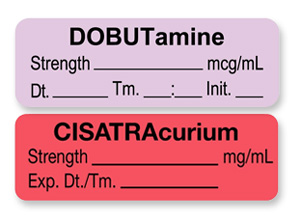Although the pharmacy shelf is not the grocery store dry goods aisle, similar circumstances can cause medication dispensing errors in your practice. Time pressure, patient distractions, confirmation bias, and packaging and name similarities all contribute to the problem. Although the FDA and Institute for Safe Medication Practices (ISMP) have instituted policies to minimize these issues, medication mix-ups still occur. But, there are process steps that can help prevent these mix-ups from occurring.
Medication Dispensing Risks
Duffy, a 14-year-old West Highland Terrier, had a skin infection. To combat the problem the vet prescribed Chloramphenicol. But, when his owner brought him home and started his medication, the owner misread the label. Instead of once a day, he gave Duffy the medicine four times in one day. After severe vomiting, he rushed Duffy back to the vet who discovered the problem. Fortunately, their quick reaction allowed him to avoid any long-term side effects.
In fact, the majority of medical errors are medication-related errors. And, when the drug label information is unclear or when one drug is mistaken for another, errors occur which may impact the animal’s health. Furthermore, errors like this one often occur at home but confusion can occur at your practice as well.
Misreading or interpreting dosage instructions is a common error. However, there are at least four other predictable problems that you can avoid by taking these process and labeling steps.
Drug Names That Look-alike Or Sound-alike
 A number of drug names have similar spellings or sound very similar. For example, the brand name drugs, “Convenia” and “Cerenia,” may look-alike on written orders. And, SINEQUAN and ZENIQUIN sound-alike when communicated verbally.
A number of drug names have similar spellings or sound very similar. For example, the brand name drugs, “Convenia” and “Cerenia,” may look-alike on written orders. And, SINEQUAN and ZENIQUIN sound-alike when communicated verbally.
Prevention Steps
Use a visual alarm to alert your staff. Warning labels including Look-alike, Sound-alike and Tallman labels help you differentiate medications. So does labeling the medication with both the generic and trade name. In addition, store seldom used look-alike or sound-alike medications away from patient care areas.
Drug Labels That Look-alike
 Although the FDA has taken steps to reduce confusion created by similar looking drug labels, there are still issues that can create problems. For example, a brand that introduces a new product often uses similar packaging. But, the new product may serve a different purpose than the original. Unfortunately, confirmation bias based on the use of that original product makes misuse of that medication more likely.
Although the FDA has taken steps to reduce confusion created by similar looking drug labels, there are still issues that can create problems. For example, a brand that introduces a new product often uses similar packaging. But, the new product may serve a different purpose than the original. Unfortunately, confirmation bias based on the use of that original product makes misuse of that medication more likely.
Prevention Steps
Add warning or medication instruction labels to highlight key information and protect against confirmation bias.
Drug Labels That Are Unreadable
The font size or style, background contrast, designs that obscure information, and overcrowded information can all make a medication label difficult to read - impacting even those pet owners with good eyesight! Furthermore, when you combine poor label design with imperfect vision, the odds of inaccurate medication dispensing increase.
Prevention Steps
There are numerous steps you can take to make medication labels easier to read including:
- Use a combination of upper- and lower-case lettering
- Create separation between the lines of print
- Highlight certain words or phrases
- Use 12-point lettering or larger
- Avoid label face stock colors that are similar to the print output (e.g., white print on a silver label).
Difficult To Use Drug Dosage Devices
 A poorly-designed oral syringe can make fill lines difficult to detect.
A poorly-designed oral syringe can make fill lines difficult to detect.
Prevention Steps
Using fill line labels applied to the dispensing device helps prevent dosage confusion.
Preventing Medication Errors
Although it’s impossible to prevent all medication dispensing errors, using effective labeling techniques can reduce their occurrence. Ensuring patient safety through accurate medication dispensing in your practice and in pet owners’ home requires ongoing diligence which you can enhance through effective communication processes.
United Ad Label
United Ad Label specializes in developing labels that enhance practice communication and safeguard against medication errors. Browse our website or contact us to learn more.